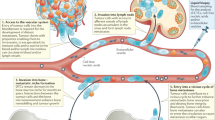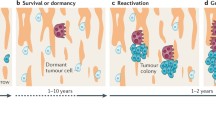Abstract
In the current study, we examine heparin’s anti-metastatic properties by using a well-defined mouse model of osteolytic bone metastasis. C57BL/6 mice were treated with increasing doses of unfractionated heparin (15, 20, or 25 units/mouse) 30 min prior to the left ventricular injection of GFP-transfected B16F10 melanoma cells. Heparin’s effect on tumour burden and bone strength was then quantified 14 days later by bone histomorphometry and biomechanical testing, respectively. Based on histomorphometric analysis of the femurs, injection of GFP-transfected melanoma cells resulted in a 37% decrease in cancellous bone volume and a 68% increase in osteoclast surface. This was associated with a 13% reduction in bone strength as measured by biomechanical testing. However, when the mice were first pre-treated with 25 units of heparin, tumour burden was decreased by 73% and tumour cell-dependent decreases in both cancellous bone volume and bone strength were prevented. Based on these observations, we conclude that heparin inhibits the ability of tumour cells to metastasize to bone and that as such, prevents tumour cell-induced decreases in bone strength.





Similar content being viewed by others
References
Mundy GR (2002) Metastasis to bone: causes, consequences and therapeutic opportunities. Nat Rev Cancer 2:584–593. doi:10.1038/nrc867
Carty NJ, Foggitt A, Hamilton CR et al (1995) Patterns of clinical metastasis in breast cancer: an analysis of 100 patients. Eur J Surg Oncol 21:607–608. doi:10.1016/S0748-7983(95)95176-8
Naume B, Borgen E, Kvalheim G et al (2001) Detection of isolated tumor cells in bone marrow in early-stage breast carcinoma patients: comparison with preoperative clinical parameters and primary tumor characteristics. Clin Cancer Res 7:4122–4129
Taback B, Giuliano AE, Hansen NM et al (2003) Detection of tumor-specific genetic alterations in bone marrow from early-stage breast cancer patients. Cancer Res 63:1884–1887
Kakkar AK, Hedges AR, Williamson RCN (1995) Perioperative heparin therapy inhibits late deaths from metastatic cancer. Int J Oncol 6:885–888
Lebeau B, Chastang C, Brechot JM et al (1994) Subcutaneous heparin treatment increases survival in small cell lung cancer. Cancer 74:38–45. doi :10.1002/1097-0142(19940701)74:1<38::AID-CNCR2820740108>3.0.CO;2-E
Prandoni P, Lensing AWA, Buller HR (1992) Comparison of subcutaneous low-molecular-weight heparin with intravenous standard heparin in proximal deep-vein thrombosis. Lancet 339:441–445. doi:10.1016/0140-6736(92)91054-C
von Tempelhoff GF, Harenberg J, Niemann F (2000) Effect of low molecular weight heparin (certoparin) versus unfractionated heparin on cancer survival following breast and pelvic cancer surgery: a prospective randomized double-blind trial. Int J Oncol 16:815–824
Altinbas M, Coskun HS, Er O et al (2004) A randomized clinical trial of combination chemotherapy with and without low-molecular-weight heparin in small cell lung cancer. J Thromb Haemost 2:1266–1271. doi:10.1111/j.1538-7836.2004.00871.x
Kakkar AK, Levine MN, Kadziola Z (2004) Low molecular weight heparin, therapy with dalteparin, and survival in advanced cancer: the fragmin advanced malignancy outcome study (FAMOUS). J Clin Oncol 22:1944–1948. doi:10.1200/JCO.2004.10.002
Smorenburg SM, Vink R, Otten HM (2001) The effects of vitamin K-antagonists on survival of patients with malignancy: a systematic analysis. Thromb Haemost 86:1586–1587
Hirsh J, Warkentin TE, Shaughnessy SG et al (2001) Heparin and low-molecular-weight heparin: mechanisms of action, pharmacokinetics, dosing, monitoring, efficacy and safety. Chest 119:64S–94S. doi:10.1378/chest.119.1_suppl.64S
Rabenstein DL (2002) Heparin and heparan sulfate: structure and function. Nat Prod Rep 19:312–331. doi:10.1039/b100916h
Harrop HA, Rider CC (1998) Heparin and its derivatives bind to HIV-1 recombinant envelope glycoproteins, rather than to recombinant HIV-1 receptor, CD4. Glycobiology 8:131–137. doi:10.1093/glycob/8.2.131
Howell AL, Taylor TH, Miller JD et al (1996) Inhibition of HIV-1 infectivity by low molecular weight heparin. Results of in vitro studies and a pilot clinical trial in patients with advanced AIDS. Int J Clin Lab Res 26:124. doi:10.1007/BF02592355
Nelson RM, Cecconi O, Roberts WG et al (1993) Heparin oligosaccharides bind L- and P-selectin and inhibit acute inflammation. Blood 82:3253–3258
Tyrrell DJ, Horne AP, Holme KR et al (1999) Heparin in inflammation: potential therapeutic applications beyond anticoagulation. Adv Pharmacol 46:151–208. doi:10.1016/S1054-3589(08)60471-8
Muir JM, Andrew M, Hirsh J et al (1996) Histomorphometric analysis of the effects of standard heparin on trabecular bone in vivo. Blood 88:1314–1320
Muir JM, Hirsh J, Weitz JI et al (1997) A histomorphometric comparison of the effects of heparin and low-molecular-weight heparin on cancellous bone in rats. Blood 89:3236–3242
Einhorn TA (1992) Bone strength: the bottom line. Calcif Tissue 51:333–339. doi:10.1007/BF00316875
Rubin CT, Rubin J (1999) Biomechanics of bone. In: Favus M (ed) Primer on the metabolic bone diseases and disorders of mineral. Lippincott, Williams and Wilkins, Philadelphia, pp 39–42
Ludwig RJ, Alban S, Bistrian R et al (2006) The ability of different forms of heparins to suppress P-selectin function in vitro correlates to their inhibitory capacity on bloodborne metastasis in vivo. Thromb Haemost 95:535–540
Bereczky B, Gilly R, Raso E et al (2005) Selective antimetastatic effect of heparins in preclinical human melanoma models is based on inhibition of migration and microvascular arrest. Clin Exp Metastasis 22:69–76. doi:10.1007/s10585-005-3859-6
Mousa SA, Lindhardt R, Francis JL et al (2006) Anti-metastatic effect of a non-anticoagulant low-molecular-weight heparin versus the standard low-molecular-weight heparin, enoxaparin. Thromb Haemost 96:816–821
Ludwig RJ, Boehme B, Podda M et al (2004) Endothelial P-selectin as a target of heparin action in experimental melanoma lung metastasis. Cancer Res 64:2743–2750. doi:10.1158/0008-5472.CAN-03-1054
Canon JR, Roudier M, Bryant R et al (2008) Inhibition of RANKL blocks skeletal tumor progression and improves survival in a mouse model of breast cancer bone metastasis. Clin Exp Metastasis 25:119–129. doi:10.1007/s10585-007-9127-1
Morony S, Capparelli C, Sarosi I et al (2001) Osteoprotegerin inhibits osteolysis and decreases skeletal tumor burden in syngeneic and nude mouse models of experimental bone metastasis. Cancer Res 61:4432–4436
Zhang J, Dai J, Qi Y et al (2001) Osteoprotegerin inhibits prostate cancer-induced osteoclastogenesis and prevents prostate tumor growth in the bone. J Clin Invest 107:1235–1244. doi:10.1172/JCI11685
Yoneda T, Michigami T, Yi B et al (2000) Actions of bisphosphonate on bone metastasis in animal models of breast carcinoma. Cancer 88:2979–2988. doi :10.1002/1097-0142(20000615)88:12+<2979::AID-CNCR13>3.0.CO;2-U
Tannehill-Gregg SH, Levine AL, Nadella MVP et al (2006) The effect of zoledronic acid and osteoprotegerin on growth of human lung cancer in the tibias of nude mice. Clin Exp Metastasis 23:19–31. doi:10.1007/s10585-006-9008-z
Shaughnessy SG, Young E, Deschamps P et al (1995) The effects of low molecular weight and standard heparin on calcium loss from fetal rat calvaria. Blood 86:1368–1373
Shigemori C, Wada H, Matsumoto K et al (1998) Tissue factor expression and metastatic potential of colorectal cancer. Thromb Haemost 80:894–898
Kaushal V, Mukunyadzi P, Siegel ER et al (2008) Expression of tissue factor in prostate cancer correlates with malignant phenotype. Appl Immunohistochem Mol Morphol 16:1–6
Ueno T, Toi M, Koike M et al (2000) Tissue factor expression in breast cancer tissues: its correlation with prognosis and plasma concentration. Br J Cancer 83:164–170. doi:10.1054/bjoc.2000.1272
Mueller BM, Reisfeld RA, Edgington TS et al (1992) Expression of tissue factor by melanoma cells promotes efficient hematogenous metastasis. Proc Natl Acad Sci USA 89:11832–11836. doi:10.1073/pnas.89.24.11832
Camerer E, Qazi AA, Duong DN et al (2005) Platelets, protease-activated receptors, and fibrinogen in hematogenous metastasis. Blood 104:397–401. doi:10.1182/blood-2004-02-0434
Karpatikin S, Pearlstein E, Ambrogio C et al (1988) Role of adhesive proteins in platelet tumor interaction in vitro and metastasis formation in vivo. J Clin Invest 81:1012–1019. doi:10.1172/JCI113411
Cohen SA, Trikha M, Mascelli MA (2000) Potential future clinical applications for the GPIIb/IIIa antagonist, abciximab in thrombosis, vascular oncological indications. Pathol Oncol Res 6:163–174
Amirkhosravi A, Mousa SA, Amaya M et al (2004) Inhibition of tumor cell-induced platelet aggregation and lung metastasis by the oral GPIIb/IIIa antagonist XV454. Thromb Haemost 90:549–554
Stevenson JL, Choi SH, Varki A (2005) Differential metastasis inhibition by clinically relevant levels of heparins—correlation with selectin inhibition, not antithrombotic activity. Clin Cancer Res 11:7003–7011. doi:10.1158/1078-0432.CCR-05-1131
Borsig L (2004) Selectins facilitate carcinoma metastasis and heparin can prevent them. News Physiol Sci 19:16–21. doi:10.1152/nips.01450.2003
Kannagi R (1997) Carbohydrate-mediated cell adhesion involved in hematogenous metastasis of cancer. Glycoconj J 14:577–584. doi:10.1023/A:1018532409041
Borsig L, Wong R, Feramisco J et al (2001) Heparin and cancer revisited: mechanistic connections involving platelets, P-selectin, carcinoma mucins and tumor metastasis. Proc Natl Acad Sci USA 98:3352–3357. doi:10.1073/pnas.061615598
Takita M, Inada M, Maruyama T et al (2007) Prostaglandin E receptor EP4 antagonist suppresses osteolysis due to bone metastasis of mouse malignant melanoma cells. FEBS Lett 581:565–571. doi:10.1016/j.febslet.2007.01.005
Bakewell SJ, Nestor P, Prasad S et al (2003) Platelet and osteoclast β3 integrins are critical for bone metastasis. Proc Natl Acad Sci USA 100:14205–14210. doi:10.1073/pnas.2234372100
Monreal M, Lafoz E, Olive A, del Rio L, Vedia C (1994) Comparison of subcutaneous unfractionated heparin with a low molecular weight heparin (Fragmin) in patients with venous thromboembolism and contraindications to Coumarin. Thromb Haemost 71:7–11
Pettila V, Leinonen P, Markkola A, Hiilesmaa V, Kaaja R (2002) Postpartum bone mineral density in women treated for thromboprophylaxis with unfractionated heparin or LMW heparin. Thromb Haemost 87:182–196
Author information
Authors and Affiliations
Corresponding author
Additional information
Supported by a Canadian Institutes of Health Team Grant in Venous Thromboembolism (#MOP-FRN-79846).
J. I. Weitz is a Career Investigator of the Heart and Stroke Foundation of Ontario (HSFO) and holds a Canada Research Chair in Thrombosis and the HSFO/J.F. Mustard Chair in Cardiovascular Research.
Rights and permissions
About this article
Cite this article
Yee, C.K., Butcher, M., Zeadin, M. et al. Inhibition of osteolytic bone metastasis by unfractionated heparin. Clin Exp Metastasis 25, 903–911 (2008). https://doi.org/10.1007/s10585-008-9212-0
Received:
Accepted:
Published:
Issue Date:
DOI: https://doi.org/10.1007/s10585-008-9212-0




